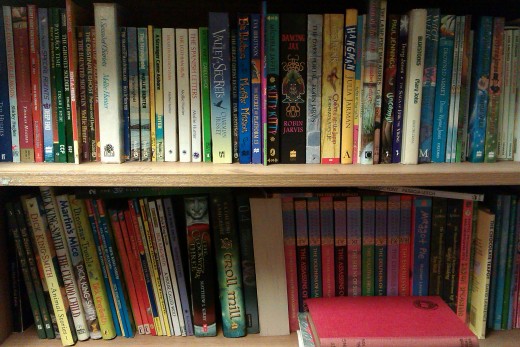- HubPages»
- Books, Literature, and Writing»
- Commercial & Creative Writing»
- Creative Writing
Show Don't Tell. An exploration of creative writing techniques
Young writers hard at work

Show Don't Tell - what does it mean?
'Show, don't tell' is a piece of writing advice which is often given to new and old writers alike. But what does it mean? And how can it improve your writing? What's so important about showing instead of telling?
As with most writing advice, it all depends on what you are writing, and, what you hope to achieve by writing it. The phrase 'show, don't tell' applies predominantly to the art of prose, (Short stories or novels) where the point in your words is to immerse the reader in a new world. To enable them to fall into your creation and let the real world slip away, even if only for a few moments. By showing your readers how your character is experiencing this fictional world, you can create a much more believable and enjoyable experience.
Don’t tell me the moon is shining; show me the glint of light on broken glass.
– Anton Chekhov
A new book is a new world to explore

How do you do it?
The first thing I would suggest is thinking about your everyday life. Was it raining this morning when you woke up? How did you know?
Did some bodiless voice boom through your head, telling you what was happening 'It is raining!'
No, probably not. But still you knew it was raining. Chances are you could hear the rain hitting against your window. Maybe you opened the curtains and saw the little splashes as the droplets hit the ground. Perhaps it wasn't till you got outside and a big fat raindrop landed on your nose.
Whatever it was that tipped you off, I'll bet you used at least one of your senses. The information was sent to your brain. Your brain translated those sensations into information, letting you know that it was raining. This is what we want to achieve with our writing.
Giving your reader the same sensory information that you would receive in real life, is essential in showing your reader what is going on, as opposed to simply telling them, it was raining.
Think about the five main senses.
Sight: I watched as little drops of water hit the ground, making thousands of little ripples in the pond.
Sound: The prattle on my umbrella was like the incessant beat of a snare drum.
Touch: The cold stung at my hands, numbness crawling up my fingers as I tried to shield my head from the fat wet drops
Smell: The fumes of the city were dampened by the thick clouds that hung over head.
Taste: I let the water run into my mouth, cool and crisp and clear.
I haven't used the word rain, but you can tell from the sensory information you have received, that it is, in fact, raining.
Now perhaps I should make it clear that I do not expect any writer to include all five when describing these details in the story, instead choose one or two that you think are the most suitable and which will give your reader the greatest sense of immersion in your tale.

Showing emotions
Looking to these five senses may be helpful in describing something of a physical nature, but what about how your character is feeling? What is the best way to immerse your reader in that aspect of your story?
Well that will again depend on the story you are writing. Is it in first person with a limited point of view, or third person with an omnipresent point of view?
But let's not get too technical, let's instead just ask the question, are we, as your reader, supposed to experience these emotions from the inside, or from the outside.
Let's start off with showing your reader how someone is feeling from the outside. How would you know that your friend was angry? They may possibly simply tell you, but it is much more likely that you would have to work it out for yourself by understanding their body language.
So what sort of signals might your friend be giving you? Maybe their hands are clenched. Or their brows drawn down. Have they raised their voice or gone icy calm? Do they glare at you? Does their jaw clench? By deciding what types of body language to use, we can show our reader that the character is angry, without ever having to use the word 'angry'.
If we take a statement like 'Jack was angry.' We can explore ways to show our reader this, rather than telling them.
Jack clenched his hands into fists at his sides, his jaws clamped together so tightly a little muscle spasmed in his cheek. He glared at me for a long moment before he spoke, the words were little more than a growl. "Get out!"
The narrator hasn't mentioned the word 'anger' but we can tell from the information we are given, that Jack is clearly angry. We have been shown the emotion, rather than told.
Now what about showing an emotion from the inside? If we take the same statement 'jack was angry' and try to show our readers this from Jack's point of view, we could again look at using the five main senses. Think about the last time you were very angry, what sort of physical effects did it have on you? Did you literally see red? Could you hear the thumping of your heart, feel the thud of your pulse? Perhaps you bit you cheek so hard you tasted blood?
By thinking about how our own bodies experience anger we can explore how Jack might experience the same emotion. Turning 'Jack was angry' into:
My hands curled into fists, my arms shaking as I tried to resist the urge to lash out, to strike Kevin down right there. Blood was pumping in my ears, drowning out everything around me. "Get out!" the words came out harsher than I'd ever heard before, as if someone else was speaking through me.
Again we haven't used the word angry. But our reader can clearly tell how Jack is feeling.
Your Challenge
Why not have a go at turning these 'tells' into 'shows'
Jane was hungry.
Think about the physicality's that would accompany this feeling. Just how hungry is she? What senses would you use to understand that you were hungry? A rumbling tummy. A lightheaded sensation, having trouble concentrating. An ache in your belly? Maybe it's more serious than that, maybe she's exhausted, malnourished. Are her clothes too big on her? Do her bones stick out? Decide for yourself just how much information your reader needs to experience the sensation along with your character.
It was freezing.
How would you know? Would you lose the feeling in your fingers? Can you see the frost on the ground? See your breath puff out like smoke? What would you hear? Snow crunching underfoot? What does cold smell like?
Resources to help you
There are plenty of resources out there to aid you in your quest to show, instead of telling. One of my favourites is: The Emotion Thesaurus: A Writer's Guide to Character Expression, by Angela Ackerman. Which is great for looking up examples of body language to fit your desired emotion, and is available in hard copy or on kindle.
Or check out Writers Write, for their body language cheat sheet:
http://writerswrite.co.za/cheat-sheets-translate-emotions-into-written-body-language
So there it is, showing isn't as hard as it might seem. Look to your own experiences and think about the five main senses, what does your character see, or hear. Can you use a characters' body language to show how someone feels instead of telling the reader?
Good luck, and happy writing! Remember, the only thing you need, is the desire to write. Everything else you can learn!





